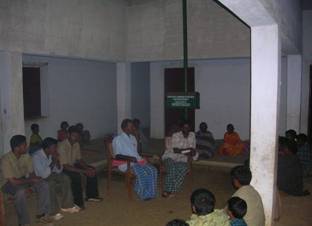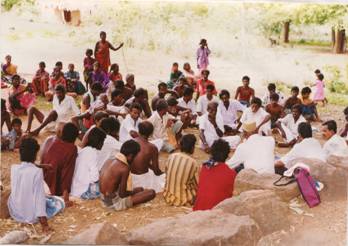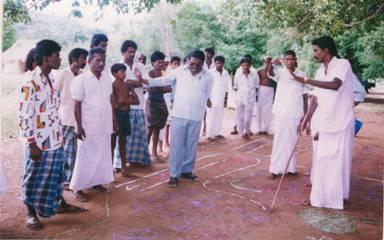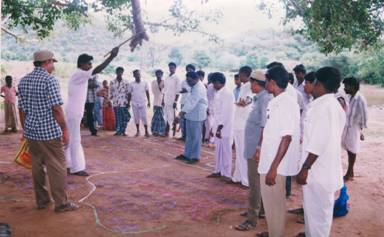
|
|||||||||
| Home | About Forestry | Eco-Tourism | Forestry Addresses | FAQs | Contact Us | Disclaimer | |
|||||||||
| JOINT FOREST MANAGEMENT | |||||||||
|
|||||||||
The foresters had long been working with the forest dwellers through the taungya system of cultivation under which the agriculture crops were raised alongwith the forest plantations for a few years. Joint Forest Management (JFM) programme in the present form can be traced to the Arabari experiment initiated by foresters in the state of West Bengal. This experiment provided a strong feedback for incorporation of the system in the National Forest Policy of 1988. In many locations people’s voluntary groups were engaged in protection of forests without any initiative from the Government. Subsequently, based on the experience, the process of institutionalizing people’s participation in forest protection and regeneration began. This type of collective endeavour in protection and management of forests through people’s involvement was later termed as Joint Forest Management.
As per the provisions of National Forest Policy 1988, the Government of India, vide letter NO.6.21/89-PP dated 1st June, 1990, outlined and conveyed to State Governments a framework for creating massive people’s movement through involvement of village committees for the protection, regeneration and development of degraded forest lands. This gave impetus to the participation of stakeholders in the management of degraded forests situated in the vicinity of villages. The joint forest management programme in the country is structured on the broad framework provided by the guidelines issued by the Ministry. So far, during the last ten years, 27 State Governments have adopted resolutions for implementing the JFM programme in their respective states. As on 15.8.2001, 14254845.95 ha of forests lands are being managed under JFM programme through 62890 committees.
The JFM programme in the country was reviewed by Government of India from time to time in consultation with State Governments, NGO’s and other stakeholders in view of several emerging issues. In order to further strengthen the programme, the State Governments may take action on the following suggested lines.
A) Legal backup to the JFM committees
i) At present, the JFM committees are being registered under different names in various States as per the provisions contained in the resolutions. Except in a few States where the committees are registered under the relevant acts in most of the states there is no legal back up for these committees. It is therefore, necessary that all the State Governments register the JFM or village committees under the Societies Registration Act, 1860 to provide them with legal back up. This may be completed by 31st March, 2000. Completion of such formation of existing JFM committees may please be reported to this Ministry.
ii) There are different nomenclatures for the JFM committees in different States. It would be better if these committees are known uniformly as JFM committees (JFMC) in all the states. Memorandum of Understanding, with clearly defined roles and responsibilities for different work or areas should be separately assigned and signed between the State Governments and the committees. All adults of the village should be eligible to become members of the JFM Committees.
 |
 |
B) Participation of women in the JFM programme:
Considering the immense potential and genuine need for women’s participation in JFM programme, following guidelines are suggested for ensuring meaningful participation of women in JFM.
i) Atleast 50% members of the JFM general body should be women. For the general body meeting, the presence of atleast 50% women members should be a prerequisit for holding the general body meeting.
ii) Atleast 33% of the membership in the JFM Executive Committee/ Management Committee should be filled from amongst the women members. The quorum for holding meeting of such Executive/ Management Committee should be one-third of women executive members or a minimum of one whichever is more. One of the posts of office bearer i.e. President/ Vice-President/ Secretary should be filled by a women members of the Committee.
C) Extension of JFM in good forest areas
For better resource planning and collective management distance from the village and dependency on forests should be the main criteria for allowing JFM programme to operate. Therefore, JFM programme should cover both the degraded as well as good forests (except the protected area network). The microplan or treatment plan and memorandum on understanding should be different for degraded forests and good forests (crown density above 40%). In good forest areas, the JFM activities would concentrate on NTFP management and no alternation should be permitted in the basic silvicultural prescription prescribed in the Working Plan but to promote regeneration, development and sustainable harvesting of NTFP which can be given free or on concessional rates as per existing practice in degraded areas under JFM. The benefit sharing mechanism will also be different for the good forest areas. The JFM committees will be eligible for benefit sharing for timber, only if they have satisfactorily protected the good forests for a minimum period of at least 10 years and the sharing percentage should be kept limited to a maximum of 20% of the revenue from the final harvest. The felling of trees and harvesting of timber will be as per the provisions of the working plan. A certain percentage of revenue from final harvest should be ploughed back in the silviculture & management of the forests. The extent of good forest areas to be allowed will depend upon the number of village household and should be restricted to a maximum limit of 100 ha and generally limited to 2 km from the village boundary. For degraded forests also as far as possible JFM should be first concentrated on areas upto 5 km from the village boundary. The implementation of JFM in good forest areas shall be done in a phased manner on pilot basis. The pilot areas may be monitored closely for a few years and based on the feedback and success achieved the programme can be extended further in consultation with the Central Government. Before allowing the good forests on pilot basis, all the degraded forests of that locality should be covered simultaneously.
D) Preparation of microplan in JFM areas:
i) In case of new working plans a JFM overlapping working circle should be provided to incorporate broad provisions for micro plans. To achieve this flexible guidelines should be evolved for preparation of local need based micro plans. For this purpose, the working plan officer will work in tandem with the territorial DFO and CF for finalisation of the prescriptions of the JFM overlapping working circle. The micro plans should be prepared by the Forest Officers and Village Forest Protection Committees after detailed PRA exercise and should reflect the consumption and livelihood needs of the local communities as well as provisions for meeting the same sustainably. It should utilize locally available knowledge as well as aim to strengthen the local institutions. It should also take into account marketing linkages for better return of NTFPs to the gatherers and should also reflect the needs of local industries/ markets. This should be done with due regards to the environmental functions and productive potentials of the forests and their carrying capacity as also their conservation and biodiversity values.
 |
 |
ii) In areas where the existing working plans are in force (till their revision in future), for incorporation of micro plans in the working plans, a special order may be issued by the PCCFs for implementation of the microplan. In these areas, micro plan should aim at ensuring a multi product and more NTFP oriented approach. Without changing the basic principles of silviculture, deviations may be approved in the existing working plans if necessary. To ensure this, the concerned DFO and CF should dovetail the requirements of micro plans with the working plans.
iii) The micro plan should also take into consideration and provide suitable advice for areas planted/ to be planted on community lands and other Government lands outside the notified forest areas including in the district council areas of North East.
iv) Infrastructure/ Ecodevelopment under micro plan should form a separate entity for funding it through concerned
development agencies.
E) Conflict resolution
In order to resolve conflicts in the functioning of JFM committees and to maintain harmony among different groups participating in the JFM, State Governments may constitute divisional and state level representative forums or working groups. This forum/ group should include representatives from all the stakeholders including NGOs. The model prescribed by the Andhra Pradesh Government for this purpose is a case in point for consideration.
F) Recognition of Self-initiated groups
The community groups in many places in Orissa, Bihar, Gujarat, Andhra Pradesh and Karnataka are performing the essential functions of forest protection and regeneration. These groups need to be identified, recognized and registered as JFM Committees after proper verification of records and enquiry. The period of their existence and duties performed for protection and regeneration should be suitable assessed and proper weightage given to them for deriving benefits under the JFM programme.
G) Contribution for Regeneration of Resoruces:
For long term sustainability of resources, it is essential that a mechanism is created for ploughing back a certain percentage of the revenue earned from final harvest. For this purpose, no less than 25% of the share of village community should be deposited in the village development fund for meeting the conservation and development from its share of such sales. There should be transparent mechanisms for computation of income for sharing the benefits between different stakeholders.
H) Monitoring and Evaluation
Concurrent monitoring of progress and performance of this programme should be undertaken at Division and State Level. Evaluation of the programme should be planned at an interval of 3 years and 5 years at Division and State level respectively.
For More details Click Here |
© All Rights Reserved. TNAU-2016